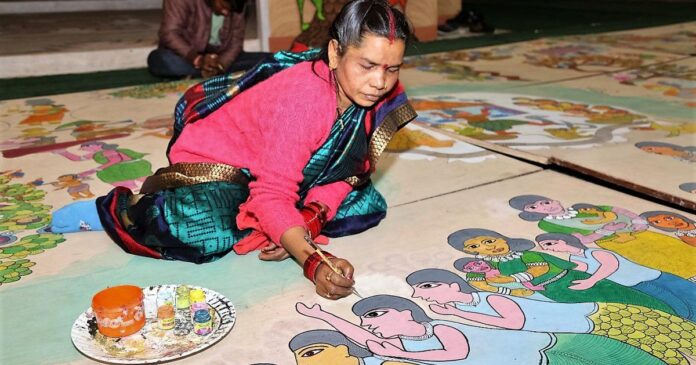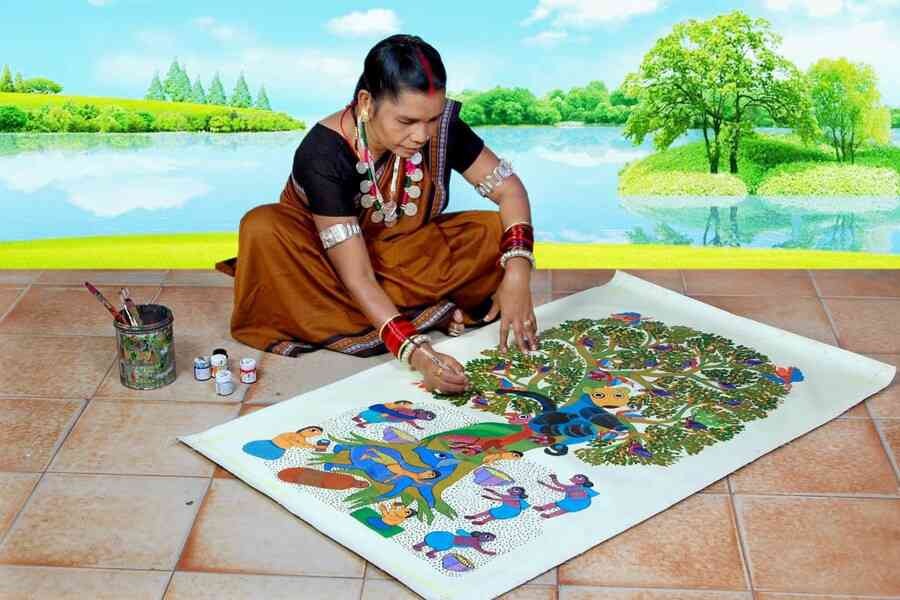
“Democracy has not eradicated caste. It has entrenched and modified it. That is why it is time to read Ambedkar.”
– Arundhati Roy, The Doctor and the Saint
Swastika Verma, TwoCircles.net
Art, in the contemporary world, has become a language and a way to express ideas. But only those who are careful and patient enough to look closely can truly understand it and uncover the small and hidden meanings behind what they see.
A solid and intentioned piece of art can be bland, a perfect or imperfect blend of one colour like charcoal art. A powerful, morbid scene depicting sorrow and gore is also art. The stone carvings at the Ellora Caves done aeons ago are also art; hence, art forms have no strict watertight norms to be followed.
In the Indian context, many cultural folk art forms have survived generations, like the Madhubani paintings of Bihar, the Miniature paintings originating during the Mughal Era, the Phad art of Rajasthan, the Kalamkari art of Andhra Pradesh and the Pardhan Gond art of Madhya Pradesh.
The Gond art is the heritage of the Gondi Tribe, a Dravidian ethno-linguistic tribal group with a majority of its population in Central India. Gond art is believed to be an offering in worship of nature, based on the cultural belief that a good image brings in good luck and wards off evil.
That is why, it was originally painted and drawn on the walls and gates of homes, highlighting the custom of their cave-dwelling Mesolithic ancestors. Being a tribal art, storytelling is the essence of their paintings, made through simple and nuanced elements like dots, lines and circles in a repetitive manner, giving a sense of balance and symmetry.
Nature plays an undeniable and divine role in the art form, narrating a story through elements of nature. Even the colours used are procured originally from nature, earthy colours made of cow dung, plant sap, flowers, leaves, soil, etc. This remarkable presence of nature gives out the message that everything comes from nature.
After centuries of existing in shadows, Jangarh Singh Shyam, a Gond farmer and artist, revived the art form for the world in the 1980s when his work was internationally recognised and acclaimed, bringing in a new set of opportunities for the entire Gond community to seek a livelihood by selling their art and supporting their large families back home.
But despite all the initial success, Shyam committed suicide in 2001 while working for a Mithila Museum in Japan at a salary of a mere Rs 12,000. He was their shepherd who made their art visible to the world, allowing it the glory it deserved. He was “the sky that sheltered the Gond heritage” and the person to whom Bhimayana is dedicated.
Published in 2011 by Delhi-based Dalit literature-centric publishing house Navayana, Bhimayana is now recognised as a graphic narrative based on the life of Babasaheb through the medium of Gond art, illuminating aspects of art and biographical storytelling to the people of a country who are mostly oblivious to the beauty of both.
The title Bhimayana is inspired by the mythological Brahmanical epic Ramayana, which means ‘Story of Rama’. So, Bhimayana is the ‘Story of Bhim’, who, in contrast to the Kshatriya Prince Rama, was an untouchable, a lawyer and a vocal advocate against caste discrimination throughout his life. The book seeks to create a parallel magnum opus for the Dalits who are kept away from reading and interpreting scriptures and holy books.
Casteism is a social evil, which is still fluidly practised. The personal story and struggles of Ambedkar failed to find the deserved attention in middle of the chaos of the Independence struggle and the Partition, and later it was mostly snubbed by caste-based propaganda, even though Babasaheb had created such a great impact both as a political writer and an activist.
So, now is the time to recreate the Ambedkar effect to fight discrimination in the modern and contemporary scenario in a unique cultural form. And the result is Bhimayana.
The visual narrative of the text is engulfing, open and easy flowing, with mind-blowing visual metaphors embedded in almost every scene, using animal imagery and elements of nature playing together to narrate the events, breaking away from the conventional norms of graphic narration.

Instead of using just one bland speech bubble, Bhimayana has a set of three speech bubbles: the bird-shaped one (for speech positive towards untouchables), the scorpion-shaped one (for speech negative towards untouchables) and the thought bubble, which has a link of three eyes resembling the mind’s eye, depicting the thinking process. To maintain a constant touch with the present caste reality in the country, leading newspaper clippings are supplemented in many chapters, further putting a stamp on the legitimacy of unacknowledged crimes against the Dalits.
In the chapter ‘Water’, Ambedkar’s sketch is drawn in the form of a fish, symbolising his thirst when he was denied water by a school peon.
In the chapter ‘Shelter’, when Ambedkar is alone in the park waiting for his ordeal of non-accommodation to be over, his face becomes the park, symbolising his loneliness.
In the Mahad Satyagraha illustrations, the microphone used by Ambedkar as he delivers his enigmatic speech on the equality of human basic rights elongates and is divided into many water pipes, sprinkling water directly into the mouths of other untouchables – an imagery that their struggle of using the common village water bodies would soon be over.
In the chapter ‘Travel’, the bus which was boarded by Ambedkar and his fellows takes the shape of Ambedkar’s head, a visualisation that Ambedkar leads them in their expedition.
The artists of Bhimayana, Durgabai and Subhash Vyam, do not believe in following the age-old traditional paradigms of graphic narratives as used by popular graphic comic narratives such as Amar Chitra Katha, Marvel and DC Comics. For a start, the Vyams were against ‘enclosing their characters in boxes and rectangles’ and used the traditional Digna pattern to separate different narratives, letting their characters ‘breathe’ in the open space and even economising the gutter space smartly.
They prefer their art to be khula (open), where the story and characters can grow as per their potential, which further points towards another interpretation that for artists, their art is as close to a living form, and they do everything in their might to make the art come alive on paper. The divisions in graphic narratives and the use of Digna patterns depict the human will to do away with man-made boundaries and a separatist approach towards normal social life.
Bhimayana’s Gond art, which has been given the liberty to merge, mix and breathe on paper, raises the question: why can’t humans be allowed to do the same? A thought which echoes Ambedkar’s wrath.
Bhimayana focuses on carving out a new regime of representation, Gond art being the carrier through which this motive is achieved. Consequently, to bring forward the plight of Dalits, it is necessary to create Dalit Aesthetics as talked about by Sharankumar Limbale. In the making of a new cultural identity, the need to break away from traditional mediums of narration and to adopt something unique in itself was felt, and Bhimayana does this exceptionally well.
The amalgamation of Gond art for representing Bhimayana symbolises ‘independence’, breaking free from any art form associated with a dominant culture, creating an alternate version of cultural memory for the Dalit community. So, Bhimayana, as a step towards ‘Dalit Realism’, tries to create or reclaim a space of cultural memory that is not stained by any paradigm of Western conventions.
Gond art represents an attachment to deep-rooted traditional values, adding a cultural flavour to Ambedkar’s story, who was denied the opportunity to savour the taste of real Hindu culture, being of a lower caste.
The modern eye fails to absorb the value of tribal artworks like the Gond paintings, often considering tribals innocent and uneducated enough to buy precious artworks at dirt-cheap prices. After Bhimayana was published, the publishers exhibited the works of the brilliant Sukhnandi Vyam, with pieces valued at their deserved rates, ranging from Rs 8,000 to Rs 2,50,000. Not a single one of the seventeen pieces of artwork was sold, and a ‘collector of tribal art’ who attended the exhibition expressed herself ‘shocked’ and ‘dispirited’ at the prices of the artworks, since she was habituated to buying Gond art at a mere Rs 500. One can imagine how humiliating and disconcerting this experience must have been for the artist, but this is the reality.
This incident brought forward the reality of the undervaluation of an artist’s dignity and their craftsmanship. To generalise an art’s worth, giving it the value it deserves, is another parameter that Bhimayana hopes to achieve. As it costs more than 300 INR, its readership is limited to the upper and well-to-do strata of society. In reality, they are the target audience of the text.
To infuse an underrated tribal art form with an unsung political leader’s life saga, creating a fusion that is entirely fresh and intriguing, is breathtaking and empowering. The driving force of Gond art to narrate Ambedkar’s caste-based struggles is an effort to bring back the ebbing glory of both the Pardhan Gond art and Ambedkar, to remind the younger generation that there is beauty in indigenous art forms and glory in the inspiring lives of people who have fought valiantly before us, for us.

